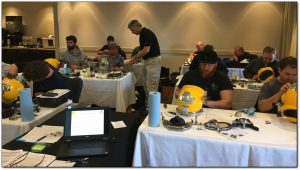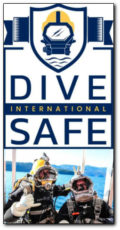The Importance of Dive Equipment Maintenance and Technical Training
By CADC Admin ~ February 17th, 2020. Filed under: EDUCATION, Training.
 (Reprint: CADC MAG WINTER 2019-20)
(Reprint: CADC MAG WINTER 2019-20)
At the time of publication, the winter diving season is well underway and, as we know, the weather conditions in Canada make it one of the more challenging places in the world to dive. The harsh environment takes its toll on personnel and equipment and so the importance of equipment maintenance and serviceability is greater than ever.
CSA standard Z275.2, Occupational safety code for diving operations, requires that a “procedure shall be in place that will provide systematic and effective maintenance of diving systems”. Among other requirements the procedure must include “manufacturers’ recommendations and manuals, where appropriate”. A similar requirement for planned maintenance is present in all diving safety codes.
The requirement for planned – or preventive – maintenance should be self-explanatory. Basically, equipment that is correctly and regularly maintained will perform better and remain serviceable for longer than the opposite approach. Planned maintenance identifies and resolves potential issues proactively before they become problems or incidents that require reaction and unplanned down-time. As the proverb says, “an ounce of prevention is worth a pound of cure”.
All diving equipment maintenance is based on manufacturer’s requirements. Historically diving equipment manufacturers use a calendar-based (e.g. annual) system as it is not only straightforward to implement but also far simpler to remember! There have been attempts to use more complex usage-based (e.g. hours) systems but each time the discussion reverts to annual overhauls for all dive equipment. We have also learned that, despite what individuals may think, the manufacturer does know best when it comes to maintaining equipment. It is a bold individual who decides to ignore the manufacturer’s requirements…
We tend to think of dive equipment as breathing apparatus only but far more falls into the category. We must not forget harnesses, BCDs, drysuits – all dive equipment requires care and maintenance.
I often highlight the terminology that we use in our industry. My preference is to use the description “Diving Life Support Equipment”. This encourages better care of the kit and highlights what we expect it to do as well as promoting a safety culture. It can also help with obtaining money for equipment maintenance. In this regard we can learn from the aviation industry where the term “Aviation Life Support Equipment” is used extensively and recognized as essential to the well-being of personnel and to successful completion of the job.
Many military and professional organizations, including commercial diving contractors and public service diving teams, have a policy of training their own employees as dive equipment technicians. This qualifies the individual as a “Competent Person” as defined and required by numerous regulations and standards. Training the end-user provides flexibility, allows for proper planning and reduces time without equipment. It is also true that technical know-how makes a diver more knowledgeable about the equipment and able to recognize the early warning signs of a problem.
Manufacturer-approved technical training courses for dive equipment have been available in Canada for many years. We recognized from the outset that training must be practical in order to develop muscle memory. This is best achieved by attendees bringing their own equipment in order for a full overhaul to be completed during the class. So always check that a class involves comprehensive hands-on training instead of just “death by PowerPoint”! We also strongly recommend that first time technicians complete a full equipment overhaul soon after completion of the course in order to reinforce their newly-acquired skills. Periodic recertification is necessary: technical skills do fade and even diving equipment changes over the years.
Value of money is always an important consideration. The cost of attending a training class (with annual overhaul included) should be weighed against being able to do your own equipment maintenance (for the validity of the technician’s certificate, from 3 to 5 years) and other benefits of keeping control of your own equipment.
Today all maintenance is laid down in manufacturers’ technical manuals/checklists and must be conducted by trained (i.e. qualified) technicians. The positive effect on diver safety is obvious. It is also important for technicians to have current “in-date” certificates in order to ensure that individuals retain their knowledge and skills. Remember too that in-date certification ensures that work on diving equipment is legal and valid in eyes of the authority having jurisdiction.
The regulation and standardization of diving operations has improved dramatically from what was accepted in the past. Maintenance and technical training is no exception. Proper use and regular maintenance of dive equipment by trained technicians increases safety and prevents unplanned down-time.
Jonathan Chapple is a former UK Royal Navy clearance diving officer and the Vice-President of Aqua-Lung Canada Ltd. He is a qualified technical instructor – with in-date certification – for all Kirby Morgan, Interspiro, Apeks and Aqua-Lung Diving Life Support Equipment.






